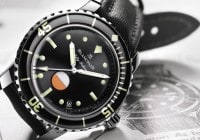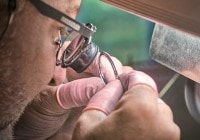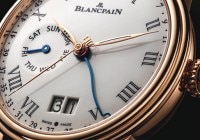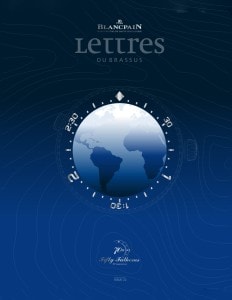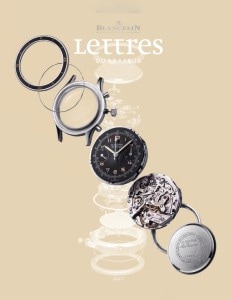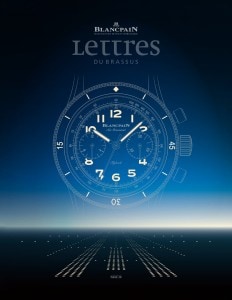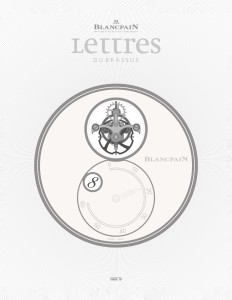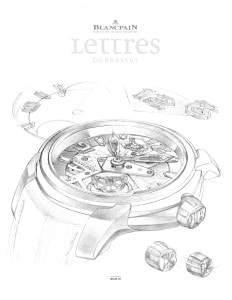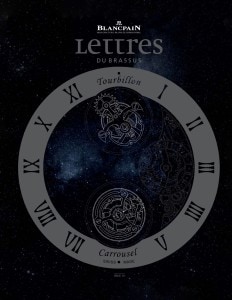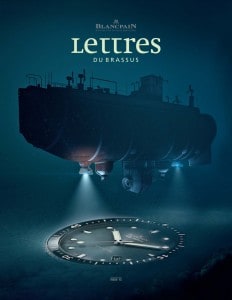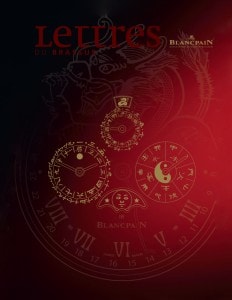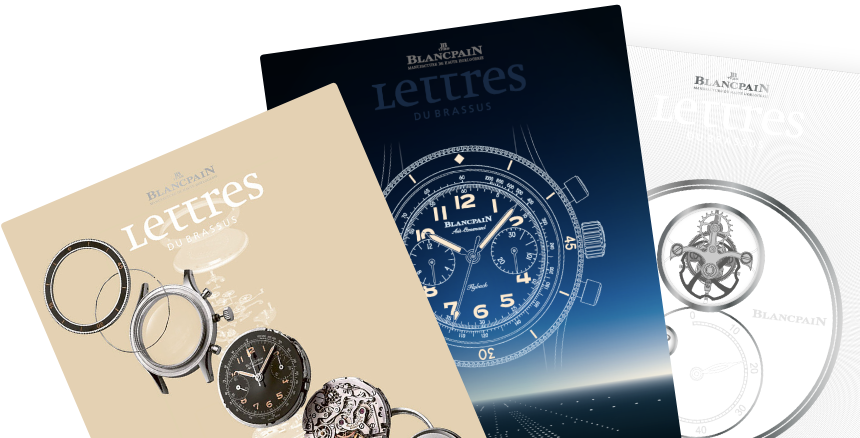
Search in Issues
Chapters
List of parts
Chapter 1
Tribute to Fifty Fathoms MIL-SPEC
The now iconic Fifty Fathoms MIL-SPEC was selected as the US Navy dive watch. The Tribute pays homage to its history.
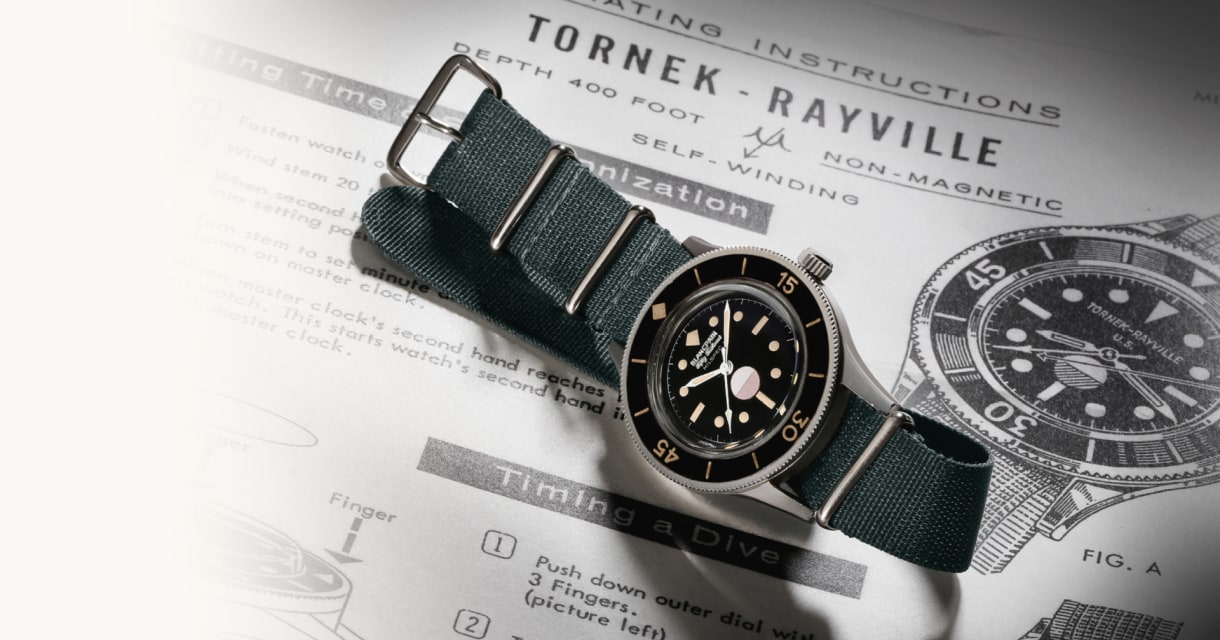
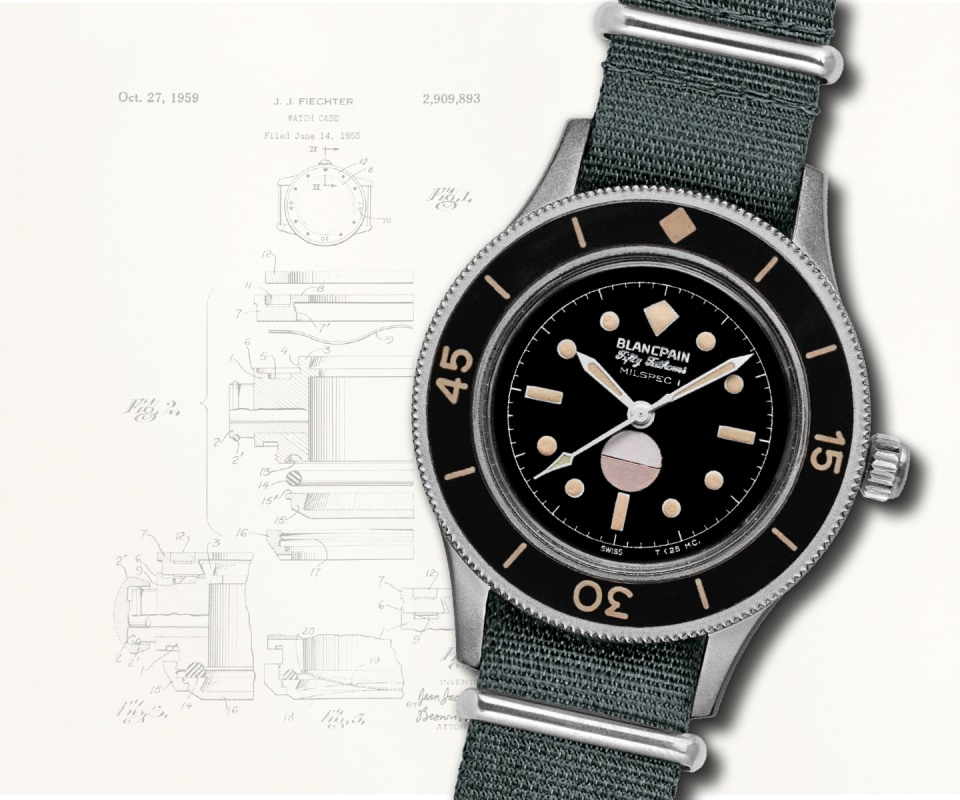
The MIL-SPEC 1 with its distinctive moisture indicator.
BLANCPAIN created the ORIGINAL TEMPLATE for modern diving watches, a FORMULA THAT ENDURES for the entire watch world today.
Hindsight is miraculous. Drawing upon its seemingly limitless powers, all of us can assume the mantle of unbounded creativity. Innovations that followed tireless brutal labors and, often, humiliating setbacks can be made to seem obvious and easy. Looking back upon the more than half century of the Blancpain Fifty Fathoms and the inspirational insights that defined its features, it is far too easy to tumble into the hindsight trap. “Well of course that’s what a diving watch had to be; aren’t they all that way?”
Yes, today there is an understood set of characteristics that nearly universally is taken to define the genre. But the reason for that is not that these elements were obvious at the beginning as hindsight might suggest; instead it is because one pioneer created the first modern diving watch and the rest of the world followed. That pioneer blazing the path was Blancpain.
The debut at Baselworld 2017 of the new Blancpain Tribute to Fifty Fathoms MIL-SPEC, which embodies all of the key features that originally defined the Fifty Fathoms plus an additional element, a moisture indicator, furnishes the occasion to retrace the evolution of the Fifty Fathoms from its birth to the creation of the two versions of MIL-SPEC Fifty Fathoms that became the diving watch for the United States Navy and secured their place in diving history as landmark timepieces.
After the end of World War II, scuba diving was in its infancy. As is often the case with a newly born field of endeavor, equipment lagged behind enthusiasm. Amateurs and professionals (at this time, military) were struggling to come to grips with the underwater world and its demands. Events transpired to place the Fifty Fathoms as a bridge between the efforts of these two groups: the amateur was Blancpain’s CEO at the time, Jean-Jacques Fiechter; the military professionals were Robert (“Bob”) Maloubier and Lieutenant Claude Riffaud of the recently formed French Navy Combat Diving Corps. In Fiechter’s amateur diving world, where he was a member of a club located in the south of France, it was not yet understood that divers
needed a watch. One dive changed all that. Without a watch to track his time underwater, Jean-Jacques Fiechter exhausted his scuba tanks. Resisting his impulses to panic, he knew that he could not sprint to
When Jean-Jacques Fiechter created the original Fifty Fathoms THERE WAS NO PRECEDENT to follow.
the surface without risk of injury; a measured ascent at the very limits of his breath was required. Of course, he survived the scare. But beyond the raw emotion of his fright, he acquired both profound insights and the inspiration to create a timing instrument for those who shared his diving passion. Returning to the Blancpain workshops, Fiechter devoted himself to designing a watch that would enable him and his fellow divers to time their dives safely, easily, and reliably.
He had no script. There was no precedent. Most horological development builds upon the foundation laid by centuries of earlier watchmaking. With no similar guidance from past watchmakers, Fiechter thrust upon himself a white piece of paper design project. What attributes must his watch possess? Watertightness, sure. But what about setting the watch in a wet environment? If a dive were being timed, how should the starting time be marked? Magnets were part of the diving environment; how could the watch be protected? What was needed to read the watch under- water? What would enhance legibility? Should it be manual wind or automatic winding? Finding answers was vital, but so, too, was even asking all the right questions.
Things were not much easier for the French military team. In one respect, they were ahead of Fiechter. They had determined in advance that their navy divers would need a timing instrument. No need for an epiphany after running out of air during a dive. That initial insight, however, did not yield a watch that worked. At the outset, they were steered toward a French watch company called LIP which happily furnished them what it considered to be a diving watch. The samples received were small, difficult to read underwater, and, worst of all, far from water resistant. In Maloubier’s words describing the tests, the watches all “drowned to death”. Other watch houses contacted by the French had nothing to offer. Eventually, the French made contact with Fiechter at Blancpain.
The bridge between the military and amateur diving worlds was formed. The French team’s ideas for what was required for their underwater missions and Fiechter’s specifications, formed from his own diving experience, meshed fully. Given samples of the Fifty Fathoms for evaluation, the French found that the Blancpain design incorporated the features that their divers required. The Fifty Fathoms samples functioned perfectly in their tests. The French Navy had its watch.
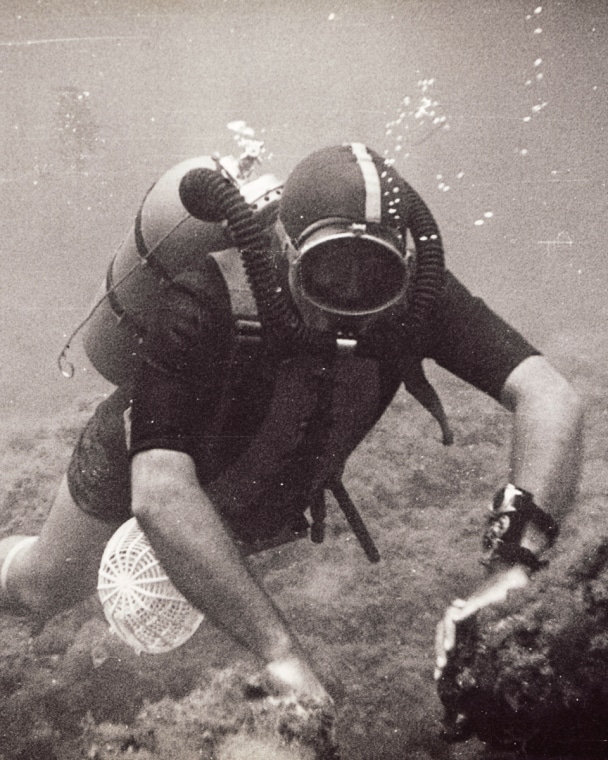
Blancpain’s then CEO Jean-Jacques Fiechter on a dive in the south of France.
The history of the Fifty Fathoms with the US Navy merits its own dedicated chapter in the LEGEND.
And what was the formula that debuted with Blancpain’s Fifty Fathoms? Superior water resistance built upon two solutions for which Fiechter obtained patents: a double sealed crown and a special seal design for the case back. The crown was particularly clever: since there were two seals, there was protection against moisture even if the crown were pulled partway out. To further ensure watertightness, Fiechter determined that the watch must have an automatic winding system. This would minimize wear on the crown sealing system that otherwise would accompany daily manual winding. Legibility was a paramount consideration since the underwater environment and masks both conspire against easy readability. So, he settled on a large size for the Fifty Fathoms and plain white indexes, bezel markings and hands against a black background. To aid reading in darkness, the indexes and hands were luminous. One ingenious feature was the rotating bezel. By placing the bezel index opposite the minute hand at the start of a dive, the elapsed time could be read directly from the bezel. And to ensure against inadvertent rotation of the bezel, Fiechter devised a locking mechanism. To aid group diving where synchronization of watches would be important, Fiechter equipped the Fifty Fathoms with a hacking mechanism to stop the watches when the crown was pulled. Thus, the group could all set time together. Finally, knowing that the diving environment was often home to strong magnets, Fiechter protected the movement from magnetism by wrapping it in an iron inner case which would function as a shield. Never before had a diving watch been constructed with this ensemble of features and designs all perfectly conceived for the underwater world and the needs of divers.
What was ideal for the French military perfectly suited the amateur, or better said, civilian, world. The Fifty Fathoms quickly established itself as an essential piece of equipment alongside tanks, breathing apparatus, masks, and fins. Such was its perception as an indispensable instrument, that the Fifty Fathoms was generally sold in diving shops. A good example is AquaLung, which along with manufacturing scuba tanks and breathing apparatus, owned retail diving equipment stores selling and renting not only gear of their own manufacture, but Fifty Fathoms watches as well. Illustrative of the close links between the Fifty Fathoms and AquaLung’s other diving gear, the watches in their shops were specially ordered from Blancpain with “Aqua Lung” written upon the dials.
The French military was not the only navy to adopt the Fifty Fathoms for its divers. It became the watch for the navies of the United States, Germany, Spain, Israel and Pakistan among others. But it is its history with the United States Navy that merits its own dedicated chapter in the larger Fifty Fathoms story. These United States Navy Fifty Fathoms watches came to be known as “MIL-SPEC”. Today, MIL-SPEC models are arguably the most coveted and sought after Fifties watches in the vintage market, with skyrocketing auction prices. And it is the MIL-SPEC patrimony that inspired Blancpain’s new limited edition Tribute to Fifty Fathoms MIL-SPEC which was a sensation at its debut during the 2017 Basel fair. We will return shortly to the description of the new limited edition piece, but first let us turn to the history that lies behind it.
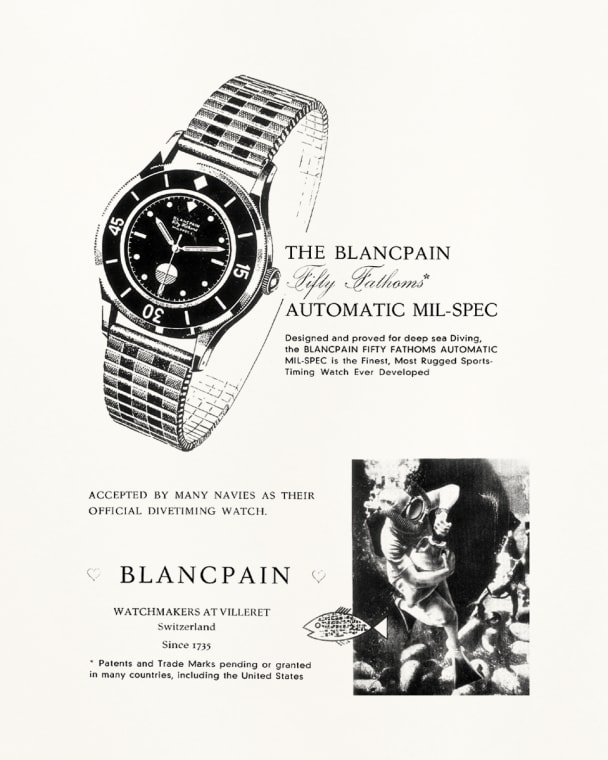
This chapter in the history of the Fifty Fathoms revolves around Blancpain’s distributor in America, Allen V. Tornek. Tornek met Jean-Jacques Fiechter’s brother, René, in New York and the two of them teamed up on a business venture aimed at avoiding punishing watch tariffs then in effect in the US. Through René, Tornek met Jean-Jacques and forged a business relationship with Blancpain that was to endure for decades.
If there has been one constant that marks the evolution of the Fifty Fathoms, it has been the pivotal role that passion for diving has played at key junctures. The watch was first created by Jean-Jacques Fiechter based on his experience as a diver. Its modern renaissance has been powered by Marc A. Hayek, today’s CEO, again flowing from his diving passion. In Tornek’s case, the passionate diver was his son Larry. During an early meeting with Fiechter, Tornek was exposed for the first time to the Fifty Fathoms. His interest was piqued because of his son’s new diving passion, so he flew home with a watch. Of course, Larry was thrilled, so much so that he still treasures the watch today, half a century later. Beyond the joy of giving a gift to his son, the purchase planted a seed in Allen V. Tornek’s thoughts. Why not look for ways to distribute the Fifty Fathoms in the United States and, having learned of the adoption by the French Navy, why not with the largest potential purchaser of them all, the US Navy?
Dealing with the labyrinthian jungle of government procurement is daunting, particularly it seems if the military is involved. Tornek knew he needed a guide and turned to a retired colonel in Washington DC for assistance. At the time, now 1955, the Navy was developing a specification for what it called “submersible wrist watches”. However difficult the process would have been in ordinary circumstances to secure a contract for Blancpain, Fiechter and Tornek had to confront a predetermined strong Navy bias in favor of one American watch company. Indeed, the Navy was crafting the specifications in concert with that potential supplier in anticipation of giving them the order. Compounding the difficulties even further, the Buy American Act would impose a series of obstacles against non-US watches, such as a rule requiring the “purchase” (keep note of that word as it will play a role as the tale unfolds) of jewels fabricated in America and, as one additional discouraging word, a 25% tariff. The deck was stacked against Blancpain.
Nonetheless Tornek attacked the problem. He flew to Switzerland and met with Jean-Jacques Fiechter.
Despite what appeared to be forbidding obstacles and a process conceived inevitably to award the contract to the American company, Fiechter and he were determined to go forward.
The 1955 draft specification plainly was not written in a vacuum. Its requirements largely mirrored the Fifty Fathoms watches that were already in the hands of other navies. It reads like a description of what Blancpain had first invented more than two years before, with one addition, a moisture indicator which, as it turns out, Blancpain had subsequently added.
Watertightness
3.6.1 Requirements, Case, General.
The case and crystal assembly shall be sealed and sufficiently rigid to withstand a hydrostatic pressure of 175 pounds per square inch (gage) with no leakage…
3.9 Requirements, Moisture Indicator.
A moisture indicator shall be securely fastened to the dial in a visible location. The free rotation of the hands shall not be affected when the indicator is in place.
Visibility in dark
3.7.1 Requirements, Dials and Hands, General.
Readability of this watch is of primary importance. It shall be able to be read in total darkness. Care should be taken to ensure that all markings are sharp edged, clean and readily distinguishable from other remote and adjacent marks.
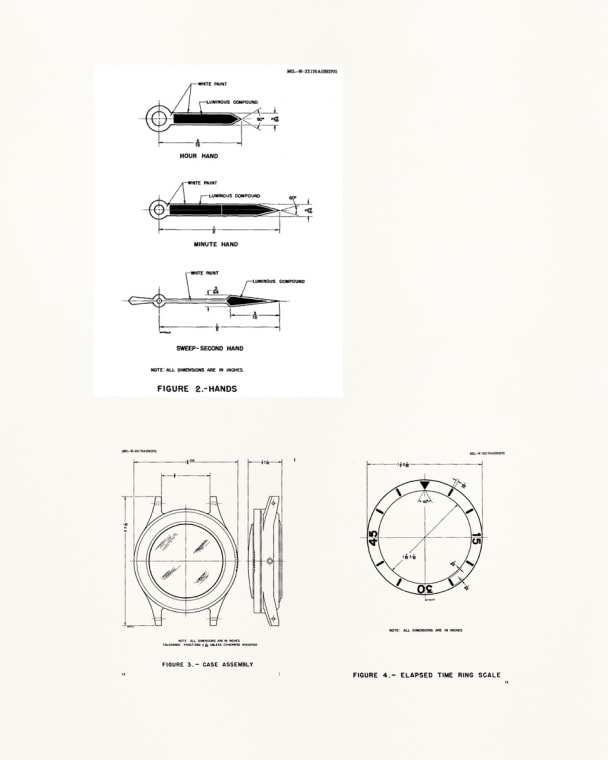
Specifications for the hands and case of the MIL-SPEC.

Since a diver ISSUED THE WATCH WITH HIS OTHER DIVING GEAR could not know if the watch had been misused by another diver, a moisture indicator on the dial represented an ADDED SAFETY MEASURE.
3.7.4 Requirements, Dials and Hands.
The three hands shall be distinctly different from each other and shall clearly stand out from the dial background when viewed in either natural daylight conditions or total darkness.
Outer, rotatable ring
3.6.6 Requirements, Case Rotatable Ring.
The watch shall be equipped with a rotatable ring in the location normally occupied by the bezel. (In use, the ring will be rotated to line up the index mark with one of the hands.) The ring shall be designed to be rotated and set by hand without tools and shall
be protected against unintentional movement caused by abrasion, shock and vibration.
While the American Navy was waiting for the “favored” US watch company to develop a watch, it needed interim supply. Its efforts were summarized in a December 1957 report where it determined that Blancpain and one other Swiss brand had watches that were considered acceptable for use.
Blancpain remained a step ahead. It already had more than two years of experience with the Fifty Fathoms. That experience led Fiechter to add one feature to his original 1953 Fifty, a moisture indicator. The idea of having a moisture indicator made sense to Fiechter. He knew that in many environments, and most particularly in the military arena, the Fifty Fathoms watches were not handled in the same way that a normal owner would utilize his personal watch. Instead of being given to a diver to keep and wear as if it were his own watch, the watches were provided to military personnel at the beginning of a mission along with the rest of the diving equipment and were returned to the equipment personnel at the conclusion of a dive. Thus, a diver would likely be diving with a different watch on each dive and, vitally, when receiving a watch along with his other gear prior to a dive, would have no idea how the watch had been previously used. Said more starkly, the diver would not know if the watch he was then being issued had been misused by someone earlier. Fiechter saw a risk in this. What if during an earlier dive, the crown had been caught on netting or had been recklessly manhandled by the diver which might have allowed moisture into the watch? Unless something had been reported, these events would be unknown to subsequent users. Fiechter’s solution was elegant. He fitted a small disk upon the dial in the 6 o’clock position that would change color in the event of a moisture intrusion. Not only was this version of the watch adopted by the French Navy, Jacques-Yves Cousteau and his team dived with them, including during their filming of the Academy Award winning film Silent World.
The US Navy verdict after testing the Blancpain: “VIRTUALLY COMPLETE SATISFACTION”.
Upon learning of the US Navy’s draft 1955 specification, Fiechter improved the design of the moisture indicator. Instead of a simple disk that would change color, he developed a bi-colored version: pale blue on one half and red on the other. In the event of moisture intrusion, the blue half of the disk would change its color to red. Thus, when a diver was issued his watch for a mission, if the blue color showed well on the disk, he could wear the watch with confidence that it had not been compromised earlier.
The series of Fifty Fathoms equipped with this bicolor moisture indicator was named “MIL-SPEC” as it was developed in conformance with the draft Navy specification.
Several Blancpain MIL-SPEC watches were tested by the US Navy in 1958. Alongside Blancpain were watches from two other Swiss companies. The watch from the American company that the Navy had been favoring was still under development and, therefore, was not tested. The approval for interim use of the Blancpain MIL-SPEC was affirmed. Indeed, it was the only watch in the test which included all the elements laid out in the still in draft form 1955 specification. Interestingly, the one other Swiss watch that had been approved for interim use alongside Blancpain in 1957 failed the test and was deleted from the US Navy’s list.
Yet another round of testing took place in 1959.
Plainly this round was occasioned by the fact that the favored American company had finally built its prototype USN watch. Far from cloaking its bias, the Navy expressly wrote that the “primary objective” for conducting this new test was to have an in-service evaluation of the American watch alongside the Swiss timepieces. In the case of Blancpain, the Navy saw no need for testing as such. It had progressed beyond testing to real world experience. The Navy wrote, “This watch [Blancpain] has not been put through any special tests since the [1958 report], but has been used in numerous working dives on a continuous basis.”
The American watch did not comport itself well. The Navy found a “tendency of the bezel ring to come off”; that its moisture indicator only worked to determine watertightness at the time of manufacture; and that the design of the face and hands was “short of optimum”. By contrast, the only watch that satisfied every single test and met all criteria was the Blancpain Fifty Fathoms MIL-SPEC. The report recites the Navy’s experience with twelve Blancpain Fifty Fathoms MIL-SPEC watches during what it called “Operation HARDTACK”. These twelve Blancpains were worn continuously for three to four months during the operation. The description of the operation speaks volumes:
“The [watches] were actively used by divers during this period and subjected to shocks and hard use during heavy work at the surface as well as to submersion.
The maximum depth of dive was 185 feet, but an extremely large number of dives were made to depths in the vicinity of 150 feet. The primary employment of the watches was to scuba diving, in which timing was extremely critical due to the depths concerned.”
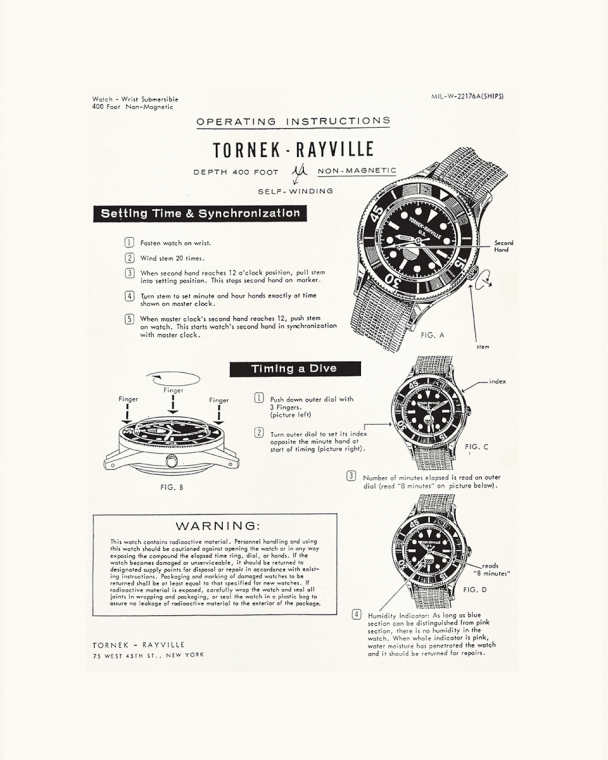
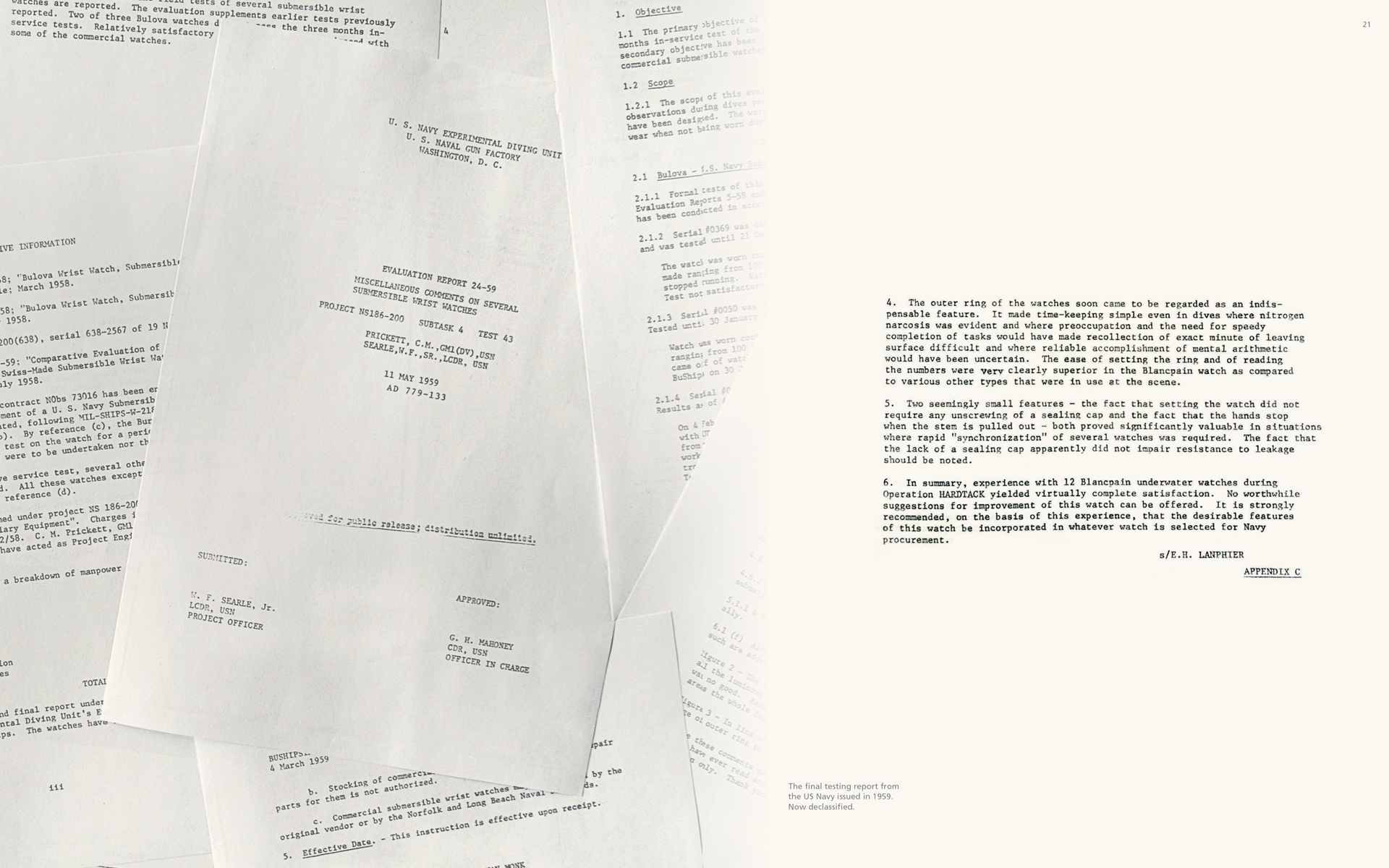
During testing the ONLY WATCH which passed all tests was the FIFTY FATHOMS.
The performance of the watches was described as “highly satisfactory” and none of the watches “gave any evidence of leakage”. The rotating bezel was called out specifically.
“The outer ring of the watches soon came to be regarded as an indispensable feature…The ease of setting the ring and of reading the numbers were very clearly superior in the Blancpain watch as compared to various other types that were in use at the scene.”
As well, two other Blancpain special features were noted:
“Two seemingly small features—the fact that setting the watch did not require any unscrewing of a sealing cap and the fact that the hands stop when the stem is pulled out—both proved significantly valuable in
situations where rapid ‘synchronization’ of several watches was required. The fact that the lack of a sealing cap apparently did not impair resistance to leakage should be noted.”
What the report is referring to are in fact two design elements that Blancpain incorporated in the Fifty Fathoms dating all the way back to Fiechter’s first versions. The movements were designed to “hack”, which means that when the crown was pulled to the time setting position, the movement is stopped. That is what allowed the ease of synchronization which is reported. The superior water resistance without the need of a screw down cap is attributable to Fiechter’s patented double sealed crown.
The conclusion of the report adds to the praise:
“In summary, experience with 12 Blancpain underwater watches during Operation HARDTACK yielded virtually complete satisfaction. No worthwhile suggestions for improvement of this watch can be offered.”
One further observation jumps off the pages of the 1959 report where all of the military criteria were listed and the performance of the timepieces recorded. The only watch rated “satisfactory” on all aspects evaluated by the Navy was the Blancpain.
Two iterations of specification were to be issued by the Navy, one in September 1959 and a follow-on version in March 1961. The difference between the two largely rests on the addition of non-magnetic criteria. The 1961 version added this element in order to guard against the watches setting off magnetically triggered mines. The Fifty Fathoms was qualified under both. The 1959 version of the specification defined the original Fifty Fathoms MIL-SPEC, which has sometimes been called the MIL-SPEC 1. The non-magnetic version defined the later Fifty Fathoms MIL-SPEC 2.1
These specifications required qualification testing at a military facility, notwithstanding all the testing that had taken place previously. The site chosen by the Navy was its Frankford Arsenal in Philadelphia which was opened in 1816 during the presidency of James Madison as a small arms and munitions facility.2
Larry Tornek vividly recalls attending the qualification testing program. Then a graduate student at the prestigious Wharton Business School in Philadelphia, Larry was nominated by his father to attend on behalf of Blancpain. The tests were brutal and one stands
out in his memory. Paragraph 4.4.9.1, conceived to test the strength of the crystal, called for placing a 40-inch-long steel tube upon the watch’s crystal and dropping a 5/8-inch solid steel ball down the tube so as to strike the crystal!
¹ The MIL-SPEC 2 watches are extremely rare today. They were constructed using special metal which had greatly reduced magnetic attraction, had a brushed finish to ensure against “sparkling” and a movement utilizing beryllium. As these watches were issued to Navy divers as military equipment and not as personal timepieces, only a scant few found their way into private hands.
² The Frankford Arsenal ceased government operations in 1977. Today it is an office park.

The Frankford Arsenal in the 1950s, a US Navy testing site.
Blancpain received contracts from the Navy for both the MIL-SPEC and MIL-SPEC 2. That, however, did not relieve Tornek and Blancpain from the provisions of the Buy American Act and the accompanying compliance gymnastics. The jewel provision was particularly amusing. It was mandated that American jewels be “purchased”. Fortunately, the requirement was for “purchase” not “use”. Since the quality of available American jewels at the time was so poor, Tornek bought the jewels—perfect compliance—and then promptly threw them away.
Considering all of the energy and effort (and wasted jewels) that Blancpain and Tornek poured into this chapter of the Fifty Fathoms, the rewards were somewhat disappointing. This was largely due to the Navy’s ordering practices. Rather than ordering large quantities at one time, orders for relatively small quantities were placed periodically. Naturally, this practice made production runs more difficult and costly. Not only were the quantities called out in each order frustratingly small, but on occasion the numbers were bizarre. One order was for 631 watches. Why not a nice round number? Because the Navy wanted 600 watches and as a backup 5% more plus one!
The third in the series of limited edition Tribute to Fifty Fathoms pieces, the MIL-SPEC has been inspired by this rich history. Its MIL-SPEC heritage is instantly seen with the presence of a bi-color moisture indicator at 6 o’clock on the dial, the same position as on the original watches. As with the original, it is the change of color which would signal any intrusion of moisture. The top half of the disk is white in color. If exposed to moisture the color will change to a warning red. The dial of the Tribute likewise recalls the Navy’s watches with its stick markers at 3, 6 and 9 and prominent dots elsewhere at five-minute intervals. Of course, there is a large marker at 12 o’clock. The Navy specification called for the dial marking “U.S.” under the name Blancpain. Naturally, that has been left out.
Creating a Tribute timepiece did not mean that Blancpain’s modern innovations would be swept aside. To the contrary, the Tribute MIL-SPEC makes use of Blancpain’s current savoir faire. The automatic winding movement is equipped with two mainspring barrels endowing the watch with a 96-hour power reserve. The balance wheel is free sprung with gold regulation screws and it is fitted with a silicium balance spring. The silicium balance spring achieves the same protection against magnetism as the vintage models’ inner iron cases. With no further need of an inner iron case, the modern Tribute has been fitted with a clear sapphire case back which affords a view of the finely finished movement including the solid gold winding rotor with a NAC coating (a platinum alloy) and Blancpain logo.
There is one other important modern attribute brought to the Tribute MIL-SPEC, its bombé sapphire
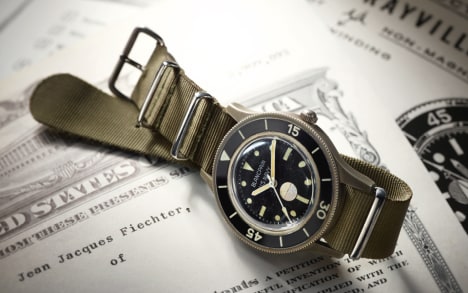
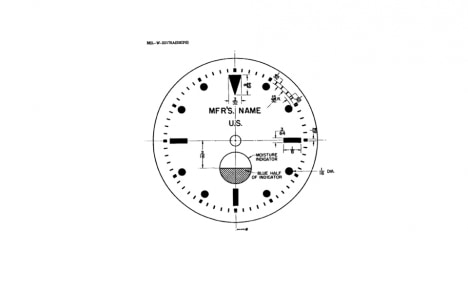
The US Navy dial specification including the mandatory moisture indicator.
bezel. Created by Blancpain in 2003 as part of the celebration of the Fifty Fathoms’ 50th anniversary, the rounded bezel has a special allure and radiance which only solid sapphire can achieve. One additional plus, bested only by diamond, sapphire is extraordinarily hard and, therefore, scratch resistant.
Historically, over the three decades that Jean-Jacques Fiechter was CEO of Blancpain, Fifty Fathoms timepieces were produced in a range of sizes. The Tribute MIL-SPEC echoes that tradition as it is 40.30 mm in diameter. Connoisseurs now have a choice of sizes within the Fifty Fathoms collection as there are models with diameters ranging from 38 mm to 58.65 mm.
One final word: the Tribute to Fifty Fathoms MIL-SPEC is limited to but 500 examples. •
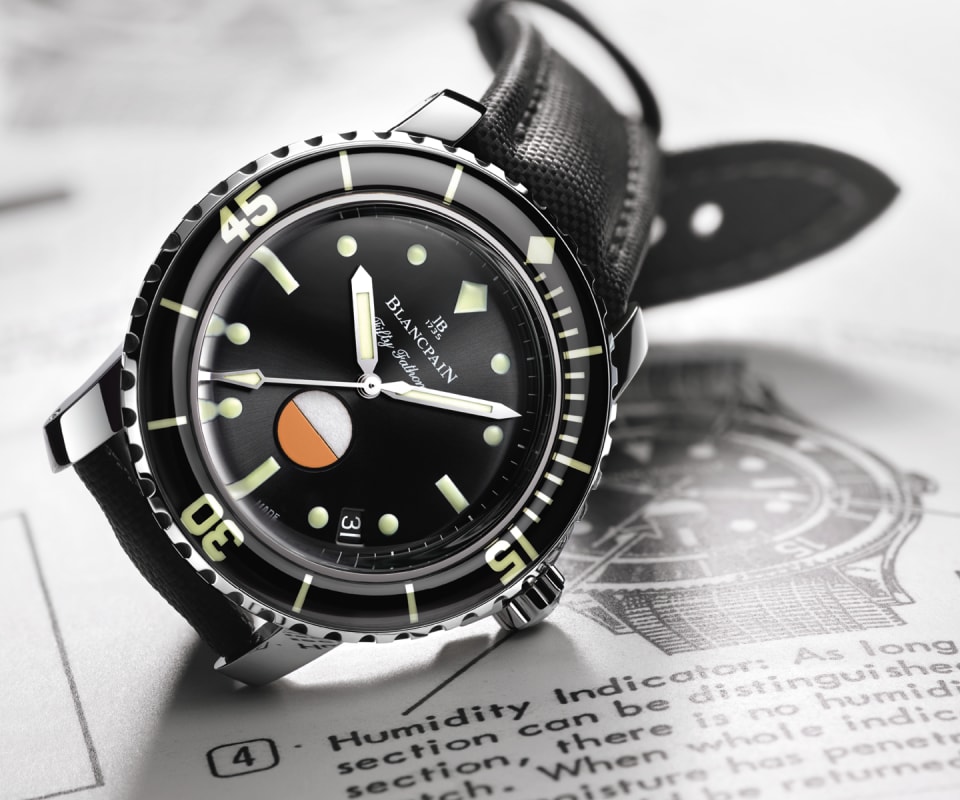
The new limited edition Tribute to Fifty Fathoms MIL-SPEC.

